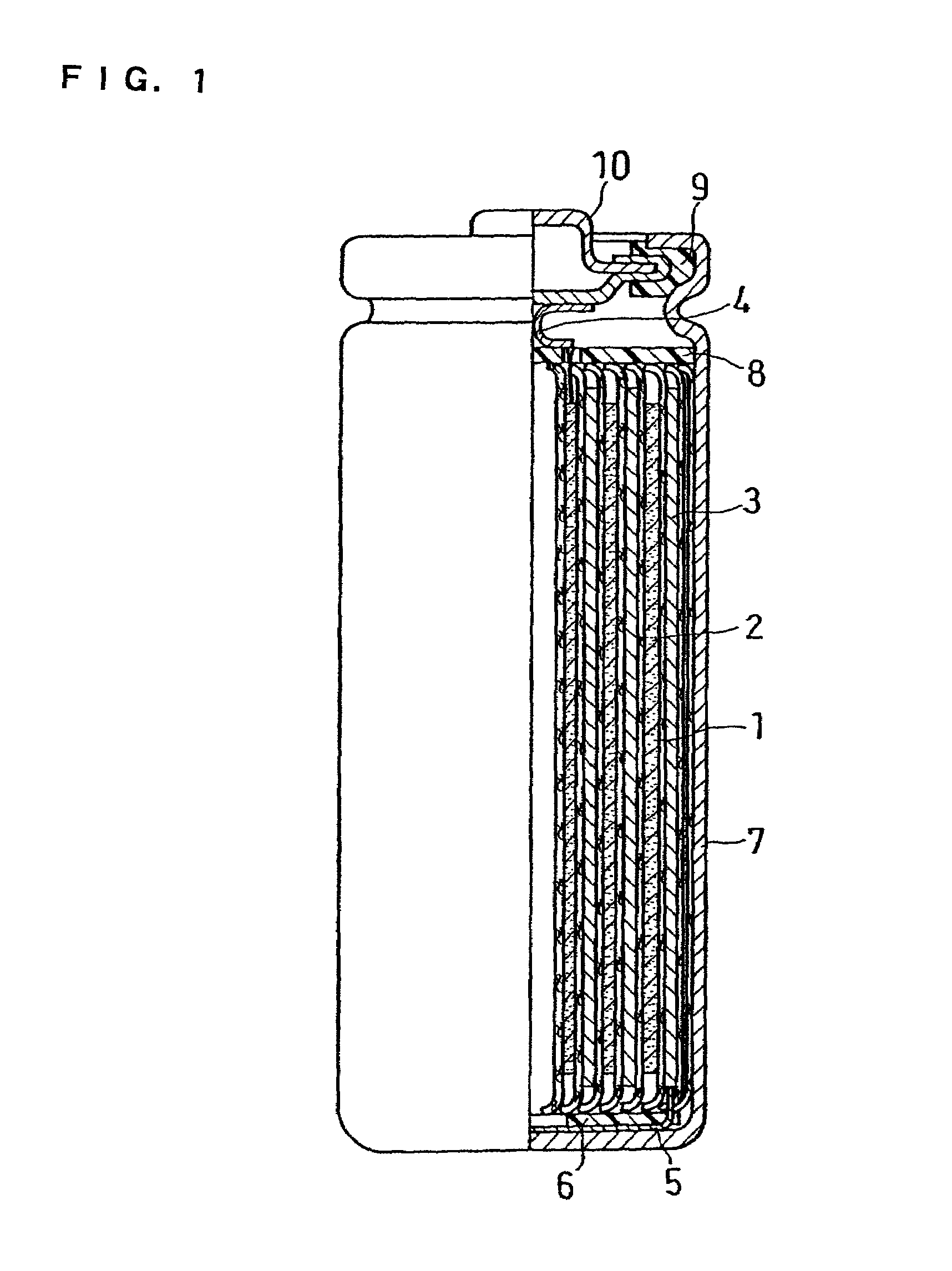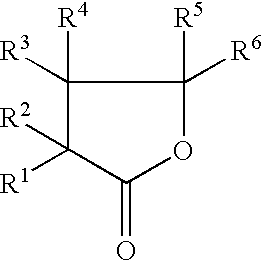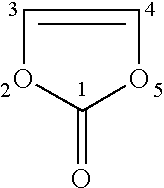Non-aqueous electrolyte secondary battery
a secondary battery and non-aqueous electrolyte technology, applied in the direction of non-aqueous electrolyte cells, cell components, electrochemical generators, etc., can solve the problems of short cycle life as the charge and discharge efficiency of the battery falls, dendritic lithium deposits, etc., to achieve satisfactory charge and discharge characteristics and excellent charge and discharge characteristics
- Summary
- Abstract
- Description
- Claims
- Application Information
AI Technical Summary
Benefits of technology
Problems solved by technology
Method used
Image
Examples
example 1
[0073]FIG. 1 shows a front view of a cylindrical non-aqueous electrolyte secondary battery having a diameter of 18 mm and a height of 65 mm, showing a vertical sectional view in the right-half portion. This battery was produced in the example in the following manner:
[0074]Via a separator 1, a band-like positive electrode plate 2 and a negative electrode plate 3 were spirally rolled up to form an electrode plate assembly. A positive electrode lead plate 4 made of aluminum and a negative electrode lead plate 5 made of nickel were respectively welded to the positive electrode plate 2 and the negative electrode plate 3. A lower insulating plate 6 made of a polyethylene resin was fixed on the bottom of the electrode plate assembly, which was accommodated in a battery case 7 made of iron with the inner surface thereof nickel-plated, and the other end of the negative electrode lead plate 5 was spot-welded to the inner bottom surface of the battery case 7. After an upper insulating plate 8 ...
example 2
[0091]Because of extremely rapid polymerization reaction of vinylene carbonate (VC) on the negative electrode, addition of an excessive amount of VC possibly causes the formation of an excessive film, which deteriorates the low temperature characteristics. The content of VC in the non-aqueous solvent was therefore studied.
[0092]Batteries 1C to 7C were produced in the same manner as the battery 2A of Example 1, except that the content of VC in the non-aqueous solvent was varied as shown in Table 4. γ-butyrolactone (GBL) as the cyclic carboxylic acid ester (A), propylene carbonate (PC) as the cyclic carbonic acid ester having no carbon-carbon unsaturated bond (C) and LiBF4 as the solute were used; the content of PC in the non-aqueous solvent was 1% by volume and the concentration of LiBF4 in the non-aqueous electrolyte was 1.25 mol / l.
[0093]The capacity maintenance rates of the resultant batteries 1C to 7C under a low temperature condition were assessed in the same manner as above in E...
example 3
[0097]Next, the content of propylene carbonate (PC) or ethylene carbonate (EC) in the non-aqueous solvent was studied.
[0098]Batteries 1D to 18D were produced in the same manner as the battery 2A or 4A of Example 1, except that the content of PC or EC in the non-aqueous solvent was varied as shown in Table 6. γ-butyrolactone (GBL) as the cyclic carboxylic acid ester (A), vinylene carbonate (VC) as the cyclic carbonic acid ester having at least one carbon-carbon unsaturated bond (B) and LiBF4 as the solute were used; the content of VC in the non-aqueous solvent was 2% by volume and the concentration of LiBF4 in the non-aqueous electrolyte was 1.25 mol / l.
[0099]The capacity maintenance rates of the resultant batteries 1D to 18D under a low temperature condition and the capacity maintenance rates of the same after storage at a high temperature were assessed in the same manner as above in Example 1. The results were shown in Table 7.
[0100]
TABLE 6Cyclic carboxylicCyclic carbonicCyclic carb...
PUM
| Property | Measurement | Unit |
|---|---|---|
| freezing point | aaaaa | aaaaa |
| freezing point | aaaaa | aaaaa |
| height | aaaaa | aaaaa |
Abstract
Description
Claims
Application Information
 Login to View More
Login to View More - R&D
- Intellectual Property
- Life Sciences
- Materials
- Tech Scout
- Unparalleled Data Quality
- Higher Quality Content
- 60% Fewer Hallucinations
Browse by: Latest US Patents, China's latest patents, Technical Efficacy Thesaurus, Application Domain, Technology Topic, Popular Technical Reports.
© 2025 PatSnap. All rights reserved.Legal|Privacy policy|Modern Slavery Act Transparency Statement|Sitemap|About US| Contact US: help@patsnap.com



